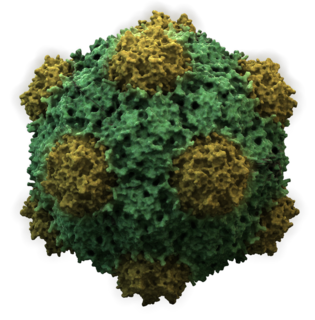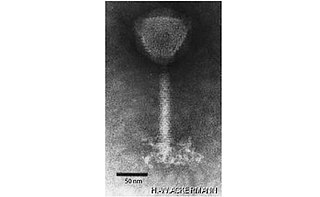
Reoviridae is a family of double-stranded RNA viruses. Member viruses have a wide host range, including vertebrates, invertebrates, plants, protists and fungi. They lack lipid envelopes and package their segmented genome within multi-layered capsids. Lack of a lipid envelope has allowed three-dimensional structures of these large complex viruses to be obtained, revealing a structural and likely evolutionary relationship to the cystovirus family of bacteriophage. There are currently 97 species in this family, divided among 15 genera in two subfamilies. Reoviruses can affect the gastrointestinal system and respiratory tract. The name "reo-" is an acronym for "respiratory enteric orphan" viruses. The term "orphan virus" refers to the fact that some of these viruses have been observed not associated with any known disease. Even though viruses in the family Reoviridae have more recently been identified with various diseases, the original name is still used.

Podoviridae is a family of viruses in the order Caudovirales. Bacteria serve as natural hosts. There are 130 species in this family, assigned to 3 subfamilies and 52 genera. This family is characterized by having very short, noncontractile tails.

Comovirinae is a subfamily of viruses in the order Picornavirales, in the family Secoviridae; its genera were formerly classified in the family Comoviridae. Plants serve as natural hosts. There are 62 species in this subfamily, assigned to 3 genera.

Tombusviridae is a family of single-stranded positive sense RNA plant viruses. There are three subfamilies, 17 genera, and 95 species in this family. The name is derived from Tomato bushy stunt virus (TBSV).

Alphaherpesvirinae is a subfamily of viruses in the family Herpesviridae, primarily distinguished by reproducing more quickly than other subfamilies in the Herpesviridae. In animal virology the most important herpesviruses belong to the Alphaherpesvirinae. Pseudorabies virus is the causative agent of Aujeszky's disease in pigs and Bovine herpesvirus 1 is the causative agent of bovine infectious rhinotracheitis and pustular vulvovaginitis. Mammals serve as natural hosts. There are currently 45 species in this subfamily, divided among 5 genera with one species unassigned to a genus. Diseases associated with this subfamily include: HHV-1 and HHV-2: skin vesicles or mucosal ulcers, rarely encephalitis and meningitis, HHV-3: chickenpox (varicella) and shingles, GaHV-2: Marek's disease.

The International Committee on Taxonomy of Viruses (ICTV) authorizes and organizes the taxonomic classification of and the nomenclatures for viruses. The ICTV has developed a universal taxonomic scheme for viruses, and thus has the means to appropriately describe, name, and classify every virus that affects living organisms. The members of the International Committee on Taxonomy of Viruses are considered expert virologists. The ICTV was formed from and is governed by the Virology Division of the International Union of Microbiological Societies. Detailed work, such as delimiting the boundaries of species within a family, typically is performed by study groups of experts in the families.

Herpesviridae is a large family of DNA viruses that cause infections and certain diseases in animals, including humans. The members of this family are also known as herpesviruses. The family name is derived from the Greek word ἕρπειν, referring to spreading cutaneous lesions, usually involving blisters, seen in flares of herpes simplex 1, herpes simplex 2 and herpes zoster (shingles). In 1971, the International Committee on the Taxonomy of Viruses (ICTV) established Herpesvirus as a genus with 23 viruses among four groups. As of 2020, 115 species are recognized, all but one of which are in one of the three subfamilies. Herpesviruses can cause both latent and lytic infections.
Betaherpesvirinae is a subfamily of viruses in the order Herpesvirales and in the family Herpesviridae. Mammals serve as natural hosts. There are 26 species in this subfamily, divided among 5 genera. Diseases associated with this subfamily include: human cytomegalovirus (HHV-5): congenital CMV infection; HHV-6: 'sixth disease' ; HHV-7: symptoms analogous to the 'sixth disease'.

The Herpesvirales is an order of dsDNA viruses with animal hosts, characterised by a common morphology consisting of an icosahedral capsid enclosed in a glycoprotein-containing lipid envelope. Common infections in humans caused by members of this order include cold sores, genital herpes, chickenpox, shingles, and glandular fever. Herpesvirales is the sole order in the class Herviviricetes, which is the sole class in the phylum Peploviricota.

Betaflexiviridae is a family of viruses in the order Tymovirales. Plants and fungi serve as natural hosts. There are 108 species in this family, assigned to 13 genera in two subfamilies. Diseases associated with this family include mosaic and ringspot symptoms.

Secoviridae is a family of viruses in the order Picornavirales. Plants serve as natural hosts. There are 8 genera and 86 species in this family, one of which is unassigned to a genus. The family was created in 2009 with the grouping of families Sequiviridae, now dissolved, and Comoviridae, now subfamily Comovirinae, along with the then unassigned genera Cheravirus, Sadwavirus, and Torradovirus.

Autographiviridae is a family of viruses in the order Caudovirales. Bacteria serve as natural hosts. There are 373 species in this family, assigned to 9 subfamilies and 133 genera.
Proboscivirus is a genus of viruses in the order Herpesvirales, in the family Herpesviridae, in the subfamily Betaherpesvirinae. Elephants serve as natural hosts. EEHV1 is apathogenic for African elephants but causes fatal haemorrhagic disease in Asian elephants. The name "Proboscivirus" comes from the Greek word προβοσκίς or "proboscis" meaning "the elephant trunk," for which the virus accordingly uses as its means of contraction and transmission to enter the elephant's body.
Alphamononivirus is a genus of enveloped, positive-strand RNA viruses in the order Nidovirales which infect planarian flatworms. Member virus planarian secretory cell nidovirus (PSCNV) has the largest known nonsegmented RNA genome of 41.1kb of any RNA virus. The genus is monotypic. It contains the subgenus Dumedivirus, which contains only one species, Planidovirus 1. Alphamononivirus is also the only member of the subfamily Mononivirinae, which in turn is the only member of family Mononiviridae, which likewise is the only member of the Monidovirineae suborder.
Gallid alphaherpesvirus 3 (GaHV-3) is a species of virus in the genus Mardivirus, subfamily Alphaherpesvirinae, family Herpesviridae, and order Herpesvirales.
Caviid betaherpesvirus 2 (CaHV-2) is a species of virus in the genus Quwivirus, in the subfamily Betaherpesvirinae, family Herpesviridae, and order Herpesvirales.
Tupaiid betaherpesvirus 1 (TuHV-1) is a species of virus in the genus Quwivirus in the subfamily Betaherpesvirinae, family Herpesviridae, and order Herpesvirales.
Ackermannviridae is a family of viruses in the order Caudovirales. Gammaproteobacteria in the phylum Pseudomonadota serve as natural hosts. There are 2 subfamilies, 10 genera, and 63 species in the family.

Herelleviridae is a family of bacterial viruses of the order Caudovirales infecting members of the phylum Firmicutes. The family has five subfamilies, 33 genera and 92 species.
Miniopterid betaherpesvirus 1 (MschBHV1) is a species of virus in the genus Quwivirus in the subfamily Betaherpesvirinae, family Herpesviridae, and order Herpesvirales.











